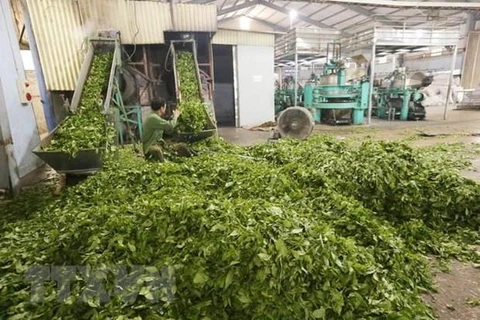 The ancient tea trees, which are several hundreds years old, grow on the Hoang Lien Son mountain range at an altitude of about 2,000 metres above sea level. (Photo: VNA)
The ancient tea trees, which are several hundreds years old, grow on the Hoang Lien Son mountain range at an altitude of about 2,000 metres above sea level. (Photo: VNA) Lai Chau (VNS/VNA) - Phong Tho, a border district with China in the northwestern province of Lai Chau, is home to over 8,000 ancient tea trees, the largest number of such trees in the region.
The ancient trees are concentrated mainly in six communes - Mo Si San, Si Lo Lau, Pa Vay Su, Tung Qua Lin, Sin Suoi, Ho, and Hoang Then.
Mo Si San commune, about 80km from Lai Chau city and over 2,000m above sea level, has more than 1,700 trees, some of which are up to 900 years old.
The unique climate and soil conditions of the commune gives the drink made from these ancient tea trees a distinctive flavour.
In Mo Si San, villagers harvest tea only once a year, from late February to April, when the ancient trees yield the best quality leaves. Additionally, due to the year-round cloud cover and low temperature at high altitudes, the trees here can only produce new leaves during this time of the year.
A specialty of the region is the wild Shan Tuyet tea that grows at altitudes from 2,000-2,500m above sea level. These trees are considered treasures and have been nurtured by the Dao ethnic community in Mo Si San.
The leaves of Shan Tuyet tea always have a fine and thick layer of hair, which when dried turns white, resembling a layer of snow.
Phong Tho district has boasted four tea products - white, black, yellow and green tea. Among them three are ancient tea products - Shan Mo Si San black, yellow and green tea have been recognised as a high quality specialty of Lai Chau province.
With prices ranging from 2-3 million VND (81-122 USD) per kilogramme, the dried wild tea leaves have brought significant income to local farmers.
According to Nguyen Canh Duc, deputy head of the Department of Agriculture and Rural Development in Phong Tho district, a project for the development and protection of ancient tea trees has been implemented in the region.
The district has successfully planted 25 hectares of new tea trees of ancient varieties in Hoang Then commune, while continuing to preserve the existing 8,000 ancient tea trees./.
.




















